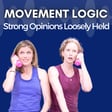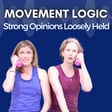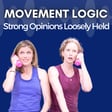
92: Make Dr. Loren Fishman Make Sense
In this episode of the Movement Logic podcast, Laurel and Sarah dissect a recent email they received from Dr. Loren Fishman, in which he expressed frustration over their critique of his study on yoga and bone density. In this episode, they address Fishman's email and take another look at his study, Twelve-Minute Daily Yoga Regimen Reverses Osteoporotic Bone Loss. Laurel and Sarah's conversation explores claims made in the email, as well as Fishman's study’s methodology and findings. They compare his claims against established evidence on bone adaptation and emphasize the importance of high-load and high-impact exercise for building bone. They also highlight the need for exercise recommendations to be grounded in solid, evidence-based research—especially for women looking to prevent or reverse osteoporosis and osteopenia.
Get on the wait list for our Bone Density Course: Lift for Longevity
Follow Movement Logic on Instagram
00:00 Introduction
00:47 Personal Updates & Course Insights
14:25 Critique of Dr. Fishman's Yoga Study
52:45 Critique of Yoga's Efficacy in Bone Building
53:03 Mechanostat Theory and Bone Adaptation
55:18 Challenges in Measuring Yoga's Impact on Bones
01:06:17 Dynamic vs. Isometric Contractions in Exercise
01:10:20 Unfalsifiable Claims and Scientific Inquiry
01:15:16 Turkey Studies and Sustained vs. Intermittent Loading
01:18:14 Dynamic Strength Training vs. Impact Training
01:18:28 Cellular Accommodation and Running
01:19:00 The Importance of Rate of Loading
01:21:21 Critique of Yoga for Osteoporosis Claims
01:26:24 Red Herrings and False Comparisons
01:51:41 Concluding Thoughts
REFERENCES
The poses in Fishman’s study
Tables of P values and more P values from Fishman’s study
Episode 79: Make Yoga U Make Sense
Episodes on the Movement Logic podcast 5, 38, 51, 53, 84, and 88 that referenced Fishman’s paper.
Episode 56 of the Yoga Research & Beyond podcast that looks at Fishman's paper.
LIFTMOR trial
LIFTMOR-M trial
Medex OP Randomized Controlled Trial
Meta-analysis on High-Load Resistance Training (HLRT)
Systematic Review on Pilates and Yoga
Bone "mass" and the "mechanostat": a proposal (Frost, 1987)
Molecular pathways mediating mechanical signaling in bone
Episode 82: Weird Science


